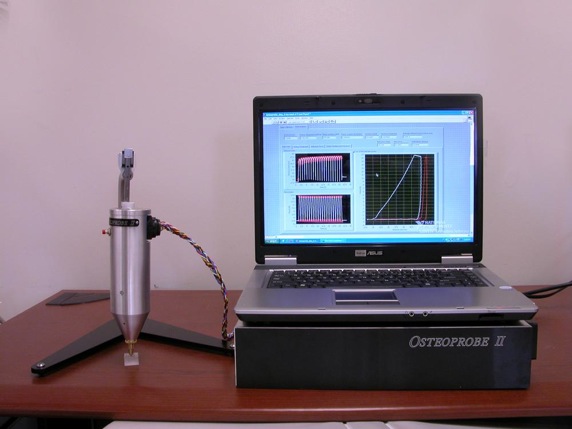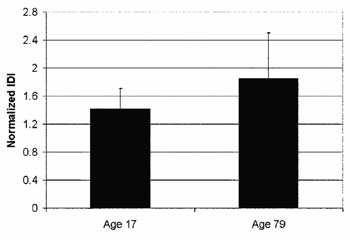Reference Point Indentation
Reference Point Indentation without a Reference Probe
Using the Osteoprobe.
The Osteoprobe is a novel, hand-held reference point indentation (RPI), instrument that is designed for clinical measurements of bone material properties in living patients. This instrument differs from previous RPI instruments in that it requires neither a reference probe nor removal of the periosteum that covers the bone, thus significantly simplifying its use in patient testing.
Reference Point Indentation with a Reference Probe

Figure 1 The current iteration of the Reference Point Indentation instrument.
Our current research is now devoted to the development of the Reference Point Indentation (RPI) instrument (formerly known as the Bone Diagnostic Instrument, BDI, and the Tissue Diagnostic Instrument, TDI). The RPI is being developed with the long-term goal of providing a way for researchers and clinicians to measure material properties of human bone in vivo. Such measurements could contribute to the overall assessment of bone fragility in the future. The portability, ease of use, and minimal training make this instrument suitable to measure bone material properties in a clinical setting.
Video: Testing of RPI in vivo, from the Hospital del Mar in Barcelona
QuickTime (Low Quality) | QuickTime (High Quality)
Windows Media (Low Quality) |
Windows Media (High Quality)
The Reference Point Indentation instrument will measure microscopic materials properties of the bones of living patients with accuracy and ease. Our hypothesis is, and our preliminary results are in agreement, that a measure of microscopic fracture resistance with the Reference Point Indentation instrument in an individual's bone correlates with their resistance to macroscopic bone fractures, or, stated another way, their overall bone fracture risk. Indentation testing is already well-established as a powerful tool in characterizing mechanical properties of materials.
Fundamental research has revealed that bone fractures begin when the organic matrix of the bone, or "glue" holding mineralized collagen fibrils together, fails causing crack propagation. Preliminary results with the Reference Point Indentation instrument have shown that an individual's susceptibility to this fundamental failure mode can be measured by indentation tests in which bone is forced, on a microscopic scale, into the same types of failure - separation of mineralized collagen fibrils - that is the root event of bone fractures. Preliminary results with the Reference Point Indentation instrument have also shown that the necessary measurement can be performed on bone that is still covered with soft tissue.

Figure 2 Basic operation of the Reference Point Indentation instrument.
The heart of the Reference Point Indentation instrument is a probe assembly that can be inserted through the skin of a living patient to measure the fracture properties of bone by creating microscopic fractures in an indentation on the surface of the bone (Figure 2). At this stage of development, the indentation distance increase (IDI) appears to best distinguish bone that is more easily fractured from bone that is less easily fractured. The IDI is a measure of the difference in indentation after repetitive cycling to a fixed force. These indented fractured areas are very small: of order of one-thousandth of a cubic millimeter, but give important information about how easy or difficult it is to fracture the bone of an individual.

Figure 3 The normalized Indentation Distance Increase (IDI) of a 17 year old female and a 79 year old female.
For more detailed information please refer to our two papers available in the publications section.
